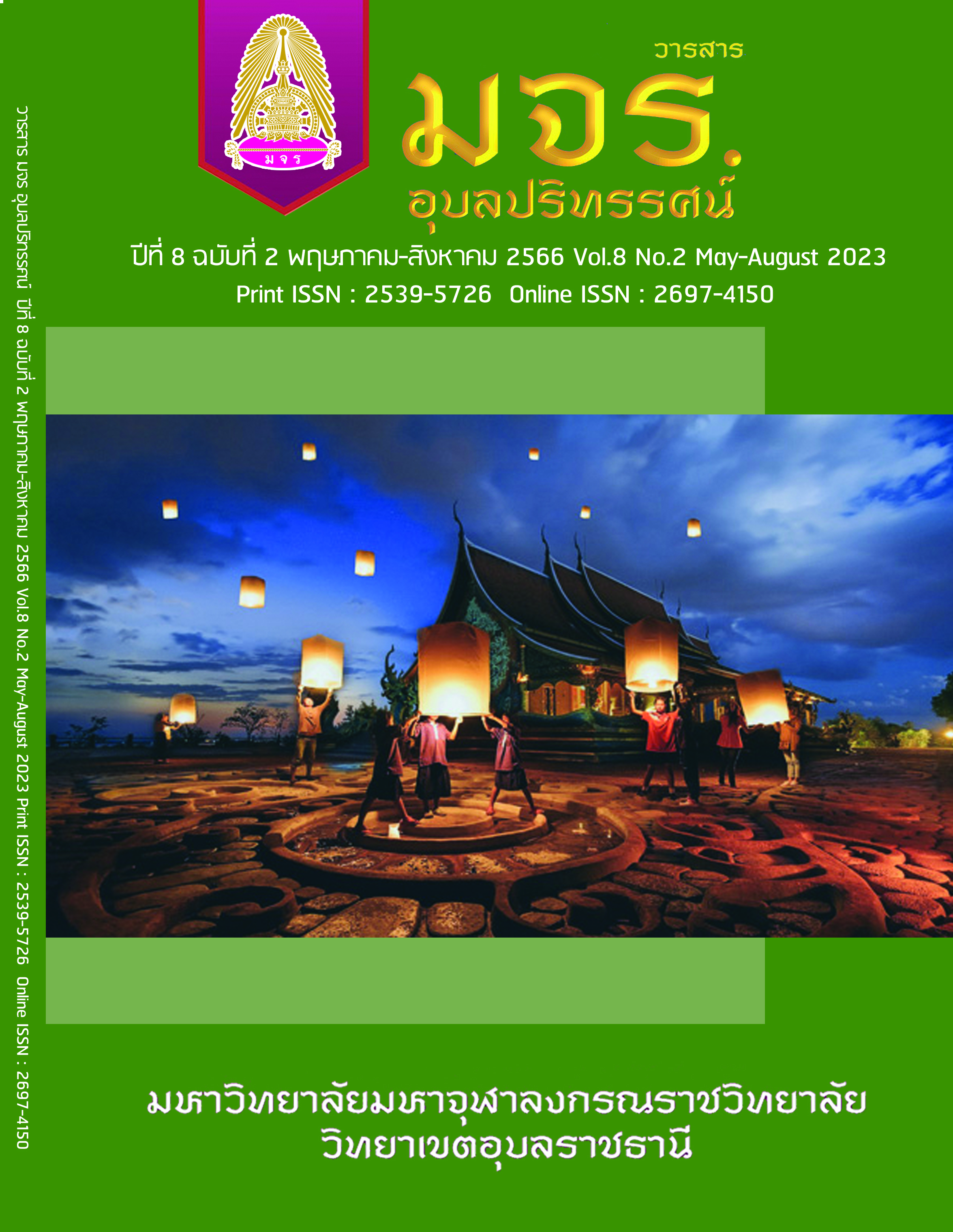PROMOTING STATISTICAL REASONING ABILITY THROUGH ACTIVITY-BASED LEARNING FOR GRADE 7 STUDENTS
Main Article Content
Abstract
The purposes of this research were to study the appropriate learning implementation and the effects of Activity-Based Learning that promote statistical reasoning ability on statistics for grade 7 students in the secondary school in Mueang Phayao District, Phayao Province. The target group were 40 students in the second semester of the academic year 2022. The researchers used the classroom action research model for 3cycles. It took totally 12 hours. The tools used in the research were lesson plans, a reflection form on learning implementation, activity sheets, and a statistical reasoning ability test. Data were analyzed using content analysis and checking for data credibility by triangulation technique. The results of the research were as follows: 1) the learning implementation approach with Activity-Based Learning which promotes statistical reasoning ability was composed of steps: introduction, activity, discussion, conclusion and application, and evaluation. There are issues that should be highlighted in using, using questions in order from easy to difficult to review knowledge, using games to create a learning atmosphere, using group activities to brainstorm and discuss information together, asking students present their work in front of the class and discuss lead to valid conclusions, encouraging students to think critically and express opinions about applying the knowledge real life and announcing scoring criteria in detail. 2) Most of the students' statistical reasoning abilities were at a very good level in all 4 components: descriptive information; Information collection and change information presentation and data analysis and interpretation.
Article Details
References
จักรพันธ์ คุณา. (2559). การจัดการเรียนรู้เพื่อส่งเสริมความสามารถในการให้เหตุผลทางคณิตศาสตร์ของนักเรียนชั้นมัธยมศึกษาปีที่ 4 โดยใช้การอภิปรายในชั้นเรียน. บัณฑิตวิทยาลัย : มหาวิทยาลัยเชียงใหม่.
จุฑาภรณ์ แสนเพ็ชร. (2560). การจัดการเรียนการสอนตามสภาพแวดล้อมการเรียนรู้ที่ส่งเสริม
การให้เหตุผลเชิงสถิติ ของนักเรียนชั้นมัธยมศึกษาปีที่ 5. บัณฑิตวิทยาลัย : มหาวิทยาลัย
เชียงใหม่.
พิลาลักษณ์ ทองทิพย์. (2550). การศึกษาการให้เหตุผลทางสถิติของนักเรียนชั้นมัธยมศึกษาปีที่ 6ในโรงเรียนสังกัดสำนักงานคณะกรรมการการศึกษาขั้นพื้นฐาน กรุงเทพมหานคร. บัณฑิตวิทยาลัย : จุฬาลงกรณ์มหาวิทยาลัย.
เพ็ญนภา ตลับกลาง. (2562). การพัฒนาผลสัมฤทธิ์การเรียนรู้คำศัพท์ภาษาอังกฤษโดยใช้วิธี
สอนกิจกรรมเป็นฐานสำหรับ นักเรียนชั้นประถมศึกษาปีที่ 2 โรงเรียนวัดเขียนเขต. บัณฑิตวิทยาลัย : มหาวิทยาลัยศิลปากร.
สำนักงานสถิติแห่งชาติ (ม.ป.ป.). ประโยชน์ของข้อมูลทางสถิติ. สืบค้นเมื่อ 19 เมษายน 2564. จากhttp://service.nso.go.th/nso/nsopublish/know/estat2_2.html
สถาบันส่งเสริมการสอนวิทยาศาสตร์และเทคโนโลยี. (2560) คู่มือการใช้หลักสูตร กลุ่มสาระ
การเรียนรู้คณิตศาสตร์ (ฉบับปรับปรุง พ.ศ. 2560). กรุงเทพฯ : สกสค. ลาดพร้าว.
สถาบันส่งเสริมการสอนวิทยาศาสตร์และเทคโนโลยี. (2561) หนังสือเรียนรายวิชาพื้นฐาน
คณิตศาสตร์ ชั้นมัธยมศึกษาปีที่ 1 เล่ม 2 กลุ่มสาระการเรียนรู้คณิตศาสตร์ (ฉบับปรับปรุงพ.ศ.2560). กรุงเทพฯ : สกสค. ลาดพร้าว.
สำนักงานคณะกรรมการการศึกษาขั้นพื้นฐาน กระทรวงศึกษาธิการ. (2560) ตัวชี้วัดและสาระการเรียนรู้แกนกลาง กลุ่มสาระการเรียนรู้คณิตศาสตร์ (ฉบับปรับปรุง พ.ศ.2560) ตามหลักสูตรแกนกลางการศึกษาขั้นพื้นฐาน พุทธศักราช 2551. กรุงเทพฯ : ชุมนุมสหกรณ์การเกษตรแห่งประเทศไทย จำกัด
เวชฤทธิ์ อังกนะภัทรขจร (2553). การศึกษาความสามารถในการให้เหตุผลเชิงสถิติของนักเรียนระดับประถมปลาย. วารสารศึกษาศาสตร์, 212), 9-22.
เวชฤทธิ์ อังกนะภัทรขจร (2556). การพัฒนาความสามารถในการให้เหตุผลเชิงสถิติและการเชื่อมโยงคณิตศาสตร์ไปสู่ชีวิตจริงโดยใช้กิจกรรมการเรียนรู้แบบการสอนแนะให้
รู้คิด (CGI) ร่วมกับการใช้คำถามระดับสูงสำหรับนักเรียนชั้นประถมศึกษาปีที่ 6.
วารสารศึกษาศาสตร์, 24(1), 15-33.
Aslam, A., and Mazher. (2015). Enhancing communication skills of ESL primary
students through activity based learning. European Journal of Language Studies, 2(1), 1-15
Awasthi, D. (2014). Activity-based Learning Methodology can bring improvement inquality of education in India. Research paper of GLRA – Global Journal for Research Analysis, 3(August).
Ayotola, A., and Ishola, A. (2013). Preparation of Primary Teachers In Pupil-CenteredActivity-Based Mathematics Instructions and Its Model. Proceeding In 1st Annual International Interdisciplinary Conference.
Ben-Zvi, D. and J.B. Garfield (2004). The challenge of developing statistical literacy, reasoning and thinking, Springer.
Gal,I.,and Garfield,J. (1997) The Assessment Challenge in Statisticals Education.Amsterdam: IOS Press and the International Statistical Institute.
Garfield, J. and D. Ben-Zvi (2008). Developing student’statistical reasoning:
Connecting research and teaching practice, Springer Science & Business
Media.
Festus. (2013). Activity -Based Learning Strategies in the Mathematics
Classrooms. Journal of Education and Practice, 4(13), 8-14.

